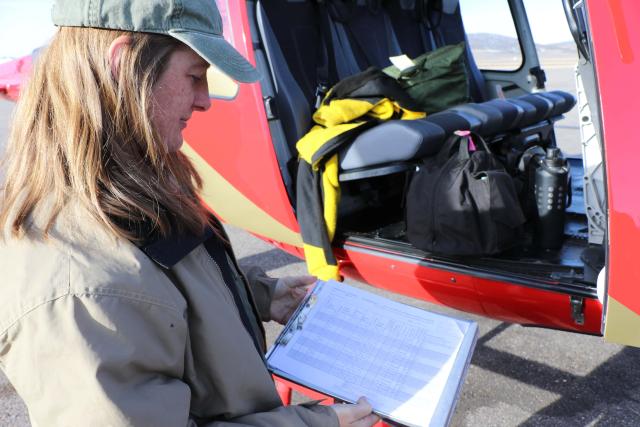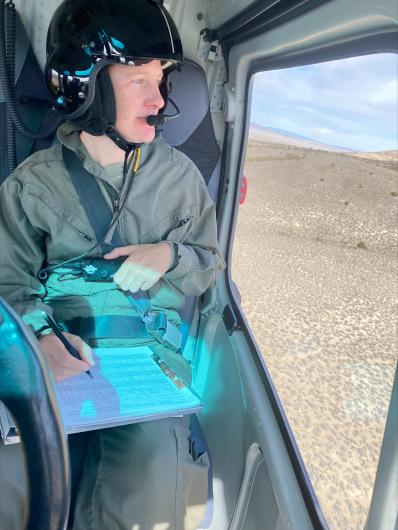You are viewing ARCHIVED content published online before January 20, 2025. Please note that this content is NOT UPDATED, and links may not work. Additionally, any previously issued diversity, equity, inclusion or gender-related guidance on this webpage should be considered rescinded. For current information, visit https://www.blm.gov/blog.
Goddess of the Grid: Estimating wild horses and burros on public lands
By Special Contributor Paula Cook
We caught up with Michelle Crabb, BLM Population Biologist stationed in Fort Collins, Colorado, to talk about the work she does supporting the surveys used to determine the accurate number of horses and burros on public land managed by the BLM. Crabb was in Ely, Nevada, flying the grid with Wild Horse and Burro Specialists Bruce Thompson from the Elko Field Office and Sadie Leyba from the Ely Field Office. We wanted to get to know Michelle a little better and gain some understanding of the rigorous protocol she manages for counting horses and burros in Herd Management Areas (HMAs).
We started with some background information, and it was quickly apparent that if we were expecting a dry, scientific discussion we were (thankfully!) at the wrong place.
Crabb said she recognized her innate curiosity and affection for details early on in life, explaining that she knew from the time she was in high school her brain operated a little differently from those of most of her peers. The Wisconsin native recalls driving to her part-time high school job at the local Piggly Wiggly. “I was driving down the road and saw something dark on the pavement in front of me, like something was spilled. I got closer and saw that it looked like oil, and I started to observe the pattern of the drips on the road. In my mind I was determining what made them fall the way they did….the vehicle must have gone over a bump and dropped a bunch of drops, then there was a clean space before it built up enough volume to drip again, and the drips were much more symmetrical on the smooth part of the road. I found it fascinating. These were the kinds of things I was thinking about when I was in high school, which wasn’t very typical I don’t think,” she said with a smile.
This inherent inquisitiveness let Crabb naturally towards a career in research. As a dedicated animal lover, she also knew she wanted to work with animals but was not necessarily interested in becoming a veterinarian. The combination of her two passions led her to a pursue degrees in biology, with an emphasis on research.
After earning her Bachelor of Science in Psychology with an emphasis in Animal Behavior from Northland College in Wisconsin, followed by a Masters of Science in Natural Resources with an emphasis in Wildlife Conservation and Management from University of Arizona, the engaging brunette embarked on a career path that can only compare to an entire season of the landmark animal program Mutual of Omaha’s Wild Kingdom. Working in a variety of temporary positions through contracts with federal and state government agencies as well as private contractors, Crabb has amassed a resume as steeped in adventure as it is in diversity and technical acumen.
“I worked in lots of different states doing a variety of projects,” Crabb said. There was a study counting Mexican wolves in Arizona and another trying to capture and tag cormorants in Arizona. “There were a whole bunch of us out in the small lake at night, in kayaks, wearing headlamps and paddling around with these nets trying to capture and tag cormorants. What they hadn’t taken into account before we launched was that the cormorants are a diving bird, so we would paddle up to them and they would just disappear,” Crabb laughed. “I was the only one in the group who was able to catch a bird. I put it in my catch bag and was paddling back to shore with it and it just kept biting me on the leg the whole time; I was saying Ow! Ow! Ow! We had to change our plan for the next phase of tagging after that!” Then there was the time she was assisting with an elk study in Arizona. The group roped and restrained a large female, and Michelle was in charge of helping to hold it down while attaching the collar. “I was sitting on this huge cow elk, and she was MAD! She started to get up and I wound up straddling her like a horse. Let me tell you, elk would not be very comfortable to ride. She had a really pointy back!”
Whether it was researching browsing deer in Mississippi, pileated woodpeckers in Oregon, tracking Canada lynx in Washington State or sneaking up on moose in Michigan, Crabb tells each story with a sense of humor and an obvious love of the animals.
So what is she doing in her new (just over a year on the job) role for the BLM? “I survey horses and burros!” she says. Crabb runs the statistical analysis of animal counts for the Bureau, a task accomplished by taking data gathered from trained observers in helicopters or fixed wing aircraft who spot and record the animals in a specified HMA, Wild Horse Territory or Herd Area. The system that Crabb and other BLM personnel use is called the simultaneous double-observer method. It’s a way of collecting data that can be analyzed to estimate the total number of animals in a surveyed area. Three observers search for animals, and the pilot just needs to fly the aircraft safely. When it comes to data analysis, the pilot and the person in the front seat are considered one ‘observer,’ and the two people in the back seat are considered to be the other ‘observer.’

Local BLM Specialists, Range Conservation Officers, fire crew and other personnel organize and oversee the aviation safety planning that happens before anyone steps into an aircraft and are the observers who conduct almost all the agency’s aerial surveys. Crabb doesn’t always go along for the flight surveys, but it is clear she enjoys that aspect and loves the technical challenge of tweaking a flight grid to maximize the accuracy of a count. Her job description calls for 20% time in the field, while her office time is spent assisting Wild Horse and Burro Specialists with creating or refining the flight grid before a survey and analyzing data supplied after a count. She then develops detailed summary memos generated by applying variables observed and animal counts noted through a code-based computer program, designated only by the name R. The R script used was developed by the United States Geological Survey specifically for wild horse and burro survey analyses, with an emphasis on identifying animals that may not actually be seen during the flight, but reason tells us must be there.
Before leading the use of the double-observer method in the BLM, Michelle had used it in burro and elk surveys, and coauthored an analysis of the method’s validity for elk surveys in Arizona. Her co-worker Paul Griffin (Research Coordinator for the BLM Wild Horse and Burro Program) talked about how important Michelle’s role is in providing reliable population estimates. “Michelle has streamlined the whole process of supporting field staff for their aerial surveys, from methods training to flight line planning, through to data analysis and interpretation. Her work helps BLM Wild Horse and Burro Specialists in almost every field office that oversees herd management areas. Having reliable herd size estimates over time is just essential, especially as we move forward with using more fertility control in herd management.”
“The simultaneous double-observer method is a more accurate way to get an estimate of actual animals on the ground,” said Crabb. Before this method was widely used, until about 2014, HMAs were often counted by a single observer, who simply noted animals seen while flying in either fixed wing or helicopter aircraft. Using the standardized in-flight data collection methods and the R script allows HMA Specialists to get a more scientific analysis of the number of animals observed, ultimately leading to better information when planning wild horse and burro management actions. “Using this peer-reviewed method of survey gives Specialists far more accurate and defensible data with which to manage their respective areas. Having a more reliable count of animals is a very valuable tool for our personnel to use when making important decisions about maintaining the health of our rangelands,” Crabb explained.

Crabb’s job is not all grids flight plans and variables though. While she does conduct extensive training sessions before each survey on the protocols required to accurately amass the data needed for the R program, another big part of her job is, well, “Teaching people to manage their stomachs so they don’t puke,” she says with a chuckle. The rapid twists and turns often required while conducting a survey can make even the most seasoned flyer reach for their airsick bag, which, incidentally, Crabb also has a protocol for. “A lot of people show up with these little Ziploc type baggies, and I tell them ‘You will be a whole lot happier with a larger bag, I can assure you!’” Not everyone does get sick of course, and to minimize your chances of that happening the number one piece of advice she gives? “No alcohol the night before!” Crabb also recommends avoiding spicy foods or things that tend to give you heartburn before flying. And if that doesn’t work? “Jolly Ranchers. A Jolly Rancher popped into your mouth when you feel like you are about to get sick kind of short-circuits the brain, makes it think that is why you are salivating. On bumpy flights you can see people just eating one after the other. You might get off the ship with quite a sugar high, but that is preferable to spending the whole time throwing up!”
The BLM is lucky to have a team member with such experience and stature amongst our ranks, lending increased credibility to our well-established methods of estimating herd size in HMAs. Asked if there is a simple way to sum up the contribution of utilizing the R program to analyze survey data, Crabb says simply, “Everyone knows you’ll miss stuff. This is an attempt to account for those missed animals.”
Well said Michelle, and welcome to the team.
Related Content
Related Stories
- Popular posts: BLM's most viewed blogs of 2025
- “Where did my horse come from?” BLM launches a new way for adopters, trainers and others to learn about their wild horses and burros
- Lake Havasu Fisheries Improvement Program is the gift that keeps giving
- BLM is thankful for public lands volunteers
- BLM delivers on administration priorities
